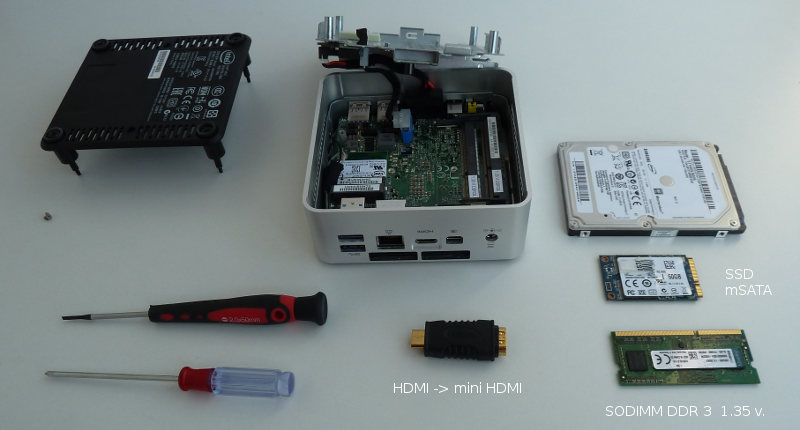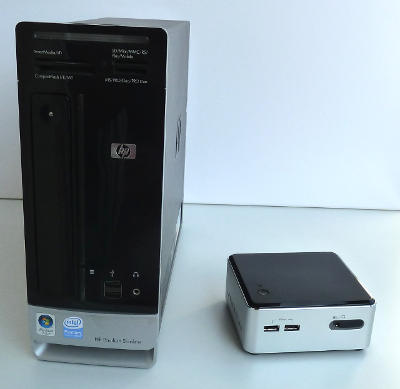Intel NUC: a desktop in the pocket
A comparison of the NUC D5425WYKH and the NUC 5i5RYH of 2015.
Until mobiles reach the power they have, these nano machines (a name given by comparison with micro computer) are the sumnum of miniaturization without any lost in performance.
The Intel NUC D54250WYKH
The D54250WYKH model corrects all flaws of its predecessors while still retaining the tiny size that should become the new format for desktops to come. The 5i5RYH adds also some components in the box.
The specifications are the same as that of a desktop, without the size and the noise. i5 processor, integrated Intel HD 5000, the last generation graphics card for 3D computations or games....
If we add two memory chips and a hard drive, a keyboard and mouse, plus if you prefer, a Windows operating system, the price is near that of a desktop. It becomes really advantageous if one already has the components and choose to install Linux.
To achieve this reduced size, about 10 cm square, laptop components are used, including components you have to install yourself : memory, mSATA SSD and optionally a 2.5 inches HDD.
With four USB 3 ports, these models let us forget the flaws of previous NUC who have only USB 2 and supported just a mSATA SSD card for storage. There is of course no CD reader as for all models of this type, but this is not essential. To install Windows or Linux, you need an external drive that plugs into the USB jack. It works seamlessly with both OS.
The assembly
The photo below shows the components required for assembly, depending on the choice of configuration :

- The case in which the hard drive bracket must be lifted to insert the other components.
- At least a cruciform screwdriver is required.
- HDMI adapter cable to the HDMI mini connector. You can also use a mini HDMI cable.
- A memory card of 4 GB, SO-DIMM DDR3L 1.35 volts.
- A mSATA SSD Kingston 64GB card. Sufficient for the intended use, we can consider a larger SSD if needed. The next generations of NUC use the M.2 format rather than mSATA.
- A Seagate Momentus 1 terabyte hard drive.
The total cost : $ 400 for the case, $ 40 for memory, $ 70 for the SSD, $ 80 for the DD.
We must still add the price of an external DVD drive to install the OS, which adds about $ 30. With the HDMI adapter, a keyboard and a mouse, this gives a total of $ 650.
This is slightly higher than the price of a desktop, but it is offset by the savings in power consumption: 65 W max vs. 250-300 W for a big box...
Furthermore it is much less expensive than an all-in-one (computer in the screen) even when the latter has a weaker configuration.
You may need to add the price of the operating system if you want to use Windows rather than Linux or ChromeOS and you do not have a generic installation DVD.
The performances
Passmark score of the i5-4250U processor is 3482.
The 3D Mark 06 score is 3024 .
To be compared with current processors for desktops and mobiles.
According to the benchmark tool of Windows 7, performances of the main parts are as follows:

DDR 3 1600 memory is slower than on a desktop, due to the low voltage (1.35 volts) of a component with low consumption.
Processor and graphic card in 3D speeds are at the level of a powerful desktop. Aero performance is strangely weak and it is what gives the final overall score, not representative of the machine.
These scores were obtained after optimization of the HD 5000 graphics card in the Intel control panel.
At first, copying large files between two USB 3.0 hard drives operated at 18MB/s while USB 2.0 on another computer is 25 MB/s! However copying between internal and external DD reached 30 MB/S. After installing the driver downloaded from the website, copy between two DD passed to 90 MB/S. It remains low but not the worst on the market and may depend also of the drives.

Size compared with a compact HP Slimline desktop!
The experience
The package includes an external power supply and a cable, it was not included in previous versions of NUC.
VESA adapter is included with the screws to attach the box on the screen if you want to gain even more space.
No CD disk is provided. So after installing Windows, no driver is available for Ethernet, Audio, Video components. Internet connection is impossible.
We must go on the manufacturer's website from another computer (this is not a problem if the NUC is intended to replace an old machine) and download the drivers.
Once the Ethernet driver installed, a connection become possible, Windows starts a wave of updates and it will result in the installation of all other drivers for the machine : it becomes fully operational.
After the fairly rapid step of assembly and the longer ones of the OS installation, we will see that there is no difference with the use of a usual desktop computer. Apart from the complete discretion of the tiny box. It is equipped with a small fan that emits a low buzz, barely audible. Mounted on the screen, the computer also becomes invisible as an all-in-one that it clearly surpasses in performances.
Intel NUC 5i5RYH
This device is the successor of the model above with still a i5 processor (i3 and i7 exist too). It belongs to the new generation of Broadwell processors, that come after the Haswell line, but with no significant performance gain.

The benchmarks generally give an improvement of 10% for this model that is not seen on these Windows tests. Note that the DD of this configuration is a M.2 SSD.
Here is a more general comparison of the two computers:
| D5425WYKH Haswell | 5i5RYH Broadwell - 2015 | |
|---|---|---|
| Processor | i5-4250U | i5-5250U |
| Graphics | Intel HD 5000 | Intel HD 6000 |
| Wifi | - | Yes |
| Bluetooth | - | Yes |
| SSD connector | mSATA | M.2 |
| DD connector | 1 SATA | 1 SATA |
| Power max. | 65 w. | 65 w. |
The advantage of the new model is mainly due to the integrated WiFi and Bluetooth This is what justifies the price difference due to the small performance gain. The support of the hard drive is now attached to the removable lid, that has allowed to slightly reduce the height. It is also quieter than the previous one, emitting a slight hum, barely audible.
The installation of internal components is as simple than with the predecessor. The most laborious task is to install drivers that must be downloaded from the Intel website (with another computer since without the RealTech driver Internet is not available!). Many archives are nested that you have to extract one by one. Some drivers are installed by an executable application. This is not the case of the graphics card, you have to access the driver installation window of Windows from the device manager.
These two steps finally completed, you have now a full desktop, silent and even invisible if it fixed behind the screen!

